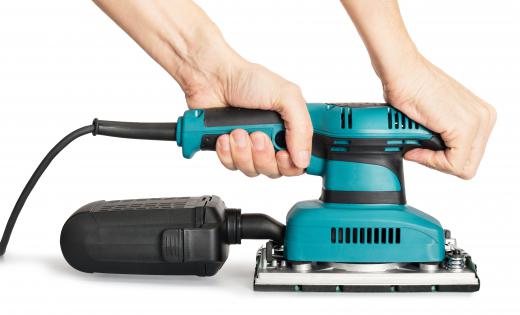A disc sander is a power tool which consists of sandpaper attached to a rotating disc used to grind and smooth surfaces of materials being worked with. It is often a very heavy sander, which includes a base and table area right in front of the rotating portion. The disc sander is one of the more common types of power sanders. This type of sander is usually stationary, unlike hand-held sander units.
In addition to this type of sander, it is possible to get a tool that will include a belt sander as well. Both operate on nearly the same principle -- that propelling the sandpaper at a high rate of speed will lead to a more efficient and complete sanding. Choosing this option will likely add somewhat to the cost, but it may be worth it. The belt sander may be used for pieces the disc sander could not handle very easily.

In addition to the disc sander, other types of sanders could also be used, depending on the job. These include random orbit sanders, the drum sander and straight-line sander. Often, one sander will be used for one type or size of material and others will be used for other pieces. However, no matter how many individual pieces there may be, it could all be part of the same project.
The disc sander is used by placing the material being worked with on a table. There are adjustments and guides that can help when working with edges that need to be exact. Once the sander is turned on, the material is then moved to come into contact with the sand paper as desired.
Many different types of materials can be used with the disc. Woodwork is, perhaps, the most common application. However, plastics and aluminum, along with other softer materials, can also be used. The owner's manual accompanying the sander should outline which materials it may be appropriate to use with the sander and which ones to avoid.
One of the benefits of the disc sander is it leaves both hands free to direct the wood as desired. Usually, this type of sander is made with heavier materials so that it will sit solidly on a level surface, making it even easier for the user. However, care should be taken that skin and clothing do not come into contact with the sander. This could lead to some very serious and painful accidents. Any children using the machine should be closely supervised and taught in proper safety procedures prior to operating the unit.
Disc sanders run the gambit in price depending on the model and features chosen. There are entry-level, factory reconditioned models that can be found for less than $100 US Dollars (USD). Professional models could run $2,000 USD or more. Most home users will likely be satisfied with a machine in the $150 USD to $350 USD price range. These models should be built solidly enough to last for years at a reasonable price.
